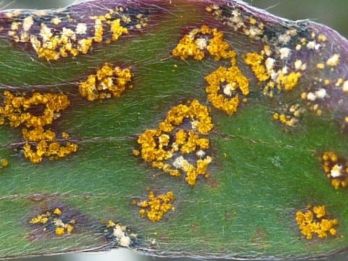Myrtle rust
Myrtle rust is a disease caused by the exotic fungus Austropuccinia psidii (formerly Puccinia psidii, identified as Uredo rangelii). It is a threat to many Australian natives and ornamentals.
Background
Overseas, there are several known strains of P. psidii. Australia has only one strain, which was first detected in April 2010.
Myrtle rust has since spread across the eastern Australian landscape, confirmed in New South Wales, Queensland, Victoria, Tasmania, and the Tiwi Islands in Northern Territory.
Myrtle rust spores were detected in SA at Nuriootpa and Uraidla in June 2021. This is not associated with any detection of disease.
Our high rainfall coastal areas are most at risk of myrtle rust, including southeast Kangaroo Island, Fleurieu Peninsula, lower Yorke Peninsula, and lower Eyre Peninsula.
Importing restrictions
Importing restrictions
To enter South Australia, Myrtaceae plants and plant material must be certified when coming from a state where myrtle rust has been detected. This includes:
- nursery stock
- cut flowers
- fruit
- germplasm
- seed
- tissue culture
- bark chips
- mulch
- firewood.
For information on plant certification, see condition 26 of the South Australian Plant Quarantine Standard (PQS).
Impacts
Myrtle rust develops in damp, moist conditions and occurs mostly in areas of high rainfall. It attacks trees and shrubs in the Myrtaceae plant family, including:
- bottle brush (Callistemon spp.)
- tea tree (Melaleuca spp.)
- eucalypts (Eucalyptus spp., Angophora spp. and Corymbia spp.)
- willow myrtle (Agonis)
- waxflower (Chamelaucium)
- New Zealand Christmas bush (Metrosideros)
- myrtle (Myrtus spp.)
- lilly pilly
- hedging syzygium (Syzygium spp.).
The disease is found in bushland reserves, home gardens, commercial operations, and amenity such as parks and street plantings. In drier areas, myrtle rust can occur in microclimates created in nurseries, glasshouses and some home gardens.
Rusts are highly transportable because they produce large numbers of tiny spores. These can be dispersed by movement of infected plant material, contaminated cutting equipment or vehicles, wind and water, animals, insects, birds, and human activity.
Identification
Myrtle rust attacks soft, growing leaves, shoot tips and young stems, and the fruits and flower parts of susceptible plants.
The first signs of myrtle rust infection are tiny, raised spots that are brown to grey, often with red-purple haloes. Up to 14 days after infection, the spots produce masses of distinctive yellow or orange spores.
The disease can cause deformed leaves, heavy defoliation of branches, reduced fertility, dieback, stunted growth, and plant death.
Early identification of myrtle rust is vital for effective management. To avoid spreading the disease, do not:
- touch, move or collect samples of the suspect plant material
- go to another site with host materials after handling suspect material.


